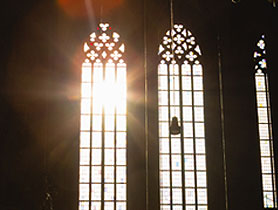The
Acts 8 Moment Blogforce proposed these two questions:
- What is the mission of the congregation?
- How should it be structured to serve its mission?
Before thinking about mission and structure, I realized I needed a working definition of what a congregation in the Episcopal Church is today. Whil e I’m sure more theologically deep and ecclesiologially sophisticated definitions could be offered, a working definition for most congregations is:
e I’m sure more theologically deep and ecclesiologially sophisticated definitions could be offered, a working definition for most congregations is:
Episcopal Congregation: a group of people who meet in the same place for worship on Sunday.
Of course, exceptions exist. Some congregations are multi-site. A few congregations worship at times other than Sunday morning. Emergent churches and fresh expressions sites are experimenting with different models. But in the end, our Book-of-Common-Prayer-based church identifies its congregations as the group of folks who gather for worship in a particular place, even if some gather at 8:00am and some at 10:00am.
Given this definition, the de facto mission of most congregations begins with hosting a Sunday morning worship service. Since the 1979 prayer book, the liturgical movement, and our increasing denominational niche as the liberal catholic church, in many places a congregation’s primary focus is offering a Sunday morning Eucharist.
I might be accused of circular logic here. If a congregation is defined by their Sunday worship, then their worship would be their primary goal. The circularity makes my argument no less true, however. This definition and mission has structural implications that are also observable. Our congregations are structured to provide Sunday morning worship as effectively as possible. Budgets focus on ensuring a priest to celebrate mass, a sanctuary, and a musician. (If you have any questions about this, look at the budget differences in most congregations for the costs associated with worship and the costs associated with almost any other mission priority.) Lay participation is often associated with liturgical ministries, as well, and the members of the choir, altar guild, acolytes, readers, ushers, etc., often outnumber people involved in other church ministries.
These details are particularly true for smaller congregations that have resources for only one or two priorities. Larger congregations with greater resources can carry out the first priority of worship effectively and still have money and volunteers to accomplish other goals.
While I agree that worship is important, and is one of the priorities of a congregation — maybe even the first among equals — our current over-focus on the Sunday morning event is killing our churches. For a congregation to thrive it needs inspiring worship, but it also needs evangelism and loving relationships and small groups and a number of other components (for one useful analysis, see the Natural Church Development materials). Too often, when things are going badly in the Episcopal Church, we tinker with our worship service rather than increasing our evangelism or starting a new ministry in the community or dealing with the conflict that drives away every visitor who actually talks to anyone at coffee hour.
Instead of making worship services the primary mission of our congregations, we should redefine our mission as creating a healthy, growing community of disciples. Worship will be one important component, but so will private devotions, fellowship opportunities, personal and corporate evangelism, and any number of other practical ways that we live out loving God, loving our neighbors and baptizing all nations while teaching them everything Jesus commanded. The mission of our congregations, and the mission of the church at every level, should involve being a community that lives out the Great Commandment and Great Commission.
The structure of congregations, then, should be whatever allows a group of people in a particular place to live into that mission. Given our traditions in the Episcopal Church, part of the structure of our congregations will involve democratically elected lay governance with appropriate clergy leadership along with financial transparency, administrative competency, connection to the diocese and larger church, and other best practices of non-profit and religious corporations.
As this refocusing of mission is happening, some places are realizing that budget, building and other resources also need to be refocused. These discussions and changes can all be very positive moves as our congregations worry less about filling our emptying pews and more about being a healthy, growing community of disciples.
Father Adam Trambley, St. John’s Sharon
 When you write, you can’t control how others interpret your words. Not completely, anyway.
When you write, you can’t control how others interpret your words. Not completely, anyway.


 e I’m sure more theologically deep and ecclesiologially sophisticated definitions could be offered, a working definition for most congregations is:
e I’m sure more theologically deep and ecclesiologially sophisticated definitions could be offered, a working definition for most congregations is:
